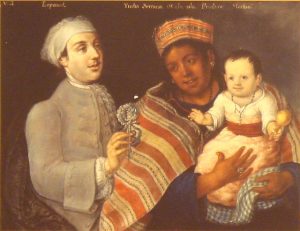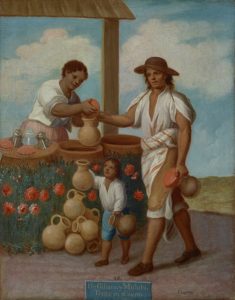Casta System
The casta system established by the Spanish as part of their settlement of the Caribbean and the Americas classified degrees of individual ancestry in order to legally and socially distinguish between the parents and the offspring, and as such made legal distinction between individuals categorized under the terminology of Indian, Black, Mulatto, Pardo, Moreno, Mestizo, Prieto, Morisco, Sambo, Lobo, etc.). Evolving from the Medieval Spanish idea of “limpieza de sangre,” the Spanish casta system in the Americas predestined legal states of labor, servitude and bondage, organizing everyday life, from what a person could wear in public to what access an individual had to legal rights and designated professions. The system evolved during the Spanish Reconquista’s systemic annihilation of purported religious impurity, which ejected individuals of Jewish and Muslim faith from Spain. The casta system was then transported to the Americas, and once in the Caribbean and Latin America, the casta system created a complex vocabulary through which to identify those legally free from those legally un-free. The casta system made a legal distinction between bodies racially classified as bodies legally categorized to be pardos and morenos were ‘free’ people of color, while bodies categorized negros and mulattos were designated as enslaved. The naming of the body via the casta system was paramount to the individual’s ability to navigate the culture and society. The “name” associated to a body was more important than what the individual body looked like. As such, two individuals with identical phenotype could be legally positioned within different casts.


For more information on the casta system read
The system determined which bodies deserved access to gradations of liberty and freedom, all the while positing Spanish ancestry as a predictor for intellectual capacity, behavior, personality, social and labor status.
During the early colonial period the system created a distinction between children of Europeans who where born in the Americas, and classifies by the system as not able to inherit the same rights as their Spanish/European born parents. But, the system centered colonial societies attention mostly on the mobility and rights of indigenous peoples from the Americas and populations from Africa, as well as adjusted for areas of Latin America that also held Chinese and Indian populations transported to the ‘new world’ as cheap labor. Since the 17th century, the system proved useful in defining legal states of bondage for Indigenous and Afrodescendant populations Later, during the prolonged process of hemispheric emancipation,’ the logic established by the casta system would continue as part and parcel of the afterlife of enslavement and inegalitarian social status.
The ways in which servitude and labor were organized under the Spanish casta system informed colonial and post-colonial society, fashioning the foundations upon which forms of colorism, classism, and labor oppression would intersect within Latin America, the Caribbean and the U.S.
A Tale of Two Systems
The casta system that still is in operation within Latin America/LatinX communities is different from notions of “hypo-descent” (the one drop rule) that operate in the U.S. during the 17th through 20th century– after the American Civil War and after the surge in what was called the Eugenics Movement (1830s-1930s). In the Caribbean, for example, under the logic of the casta system blanqeamiento projects of lightening the work force was a way to encourage mixed unions to create ‘mestizo’/’mulatto’ populations thought to be more docile. And, pigmentation alongside hair texture within the context of Latinx communities and Latin American societies played a role in determining individual progress and ability to access such things as better education, housing, employment, marriage partners, etc…
The casta system approach is very different from the rules of hypo-descent that structure categories within the U.S. As such, contemporarily Latinx population residing in the U.S. have to navigate the legacies of both systems– they may find the need to walk in both worlds. As populations residing in the U.S. they are bound to the U.S. system of hypodescent, but also when in Latinx communities/contexts find it necessary to navigate the different rules established over 400 years ago by the casta system.
By the end of the twentieth century the classifications developed under the casta system were fully interwoven into Latin American/LatinX social life.
Many of the writers, poets, artists we are covering this semester are contending with the ideals of liberty, equality and solidarity while navigating the problematic legacy of both the casta system and hypo-descent.

